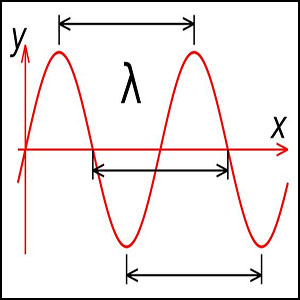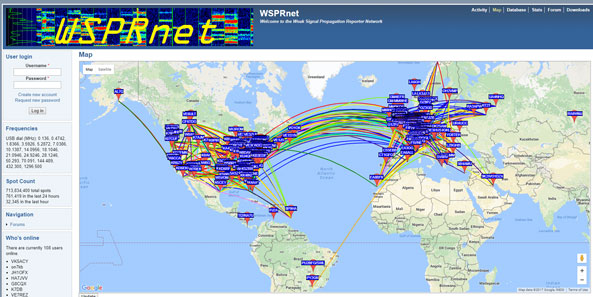Flying Squirrels #2 – Telemetry protocols
What’s the frequency Kenneth?

The big unknown for me, at least at the start, is how am I going to know where the balloon has traveled. I need to be able to send radio telemetry from the balloon back to the ground somehow.
My stated project goal that the balloon be capable of global circumnavigations, drives most of the requirements. A further requirement is that the whole package be cheap and lightweight.
At first, I read a lot about balloons sent aloft from Europe using 70cm (430-450Mhz) Radio Teletype (RTTY) as the means for sending information to the ground.
This protocol choice seemed problematic for me:
- 70cm clearly would not meet my global tracking goal as it is a line-of-sight mode, limited to relatively close distances, even at high altitude. Thus, a balloon would only be track-able in populated regions of the globe. I will need to use lower frequencies in the HF bands to go global.
- Radio modules for 70cm RTTY (Technically FSK modes) are available in Europe and can be purchased in the US. But the cost of the modules would exceed my entire flight budget. Shipping across the Atlantic added even more to the cost.
- RTTY is not a robust data mode compared to other choices available. RTTY suffers a lot from weak signal disruptions, static, QSB (Signal fading), QRM (Interfering radio signals) etc. When noise is present, RTTY suffers greatly, leaving gaps in the data received.
It turns out the reason for the 70cm band in Europe is that the rules governing ham radio over there disallow sending a transmitter high into the air. Unlike the USA, 70cm is not a ham band in Europe. It is akin to the ISM Bands here in the US and it relatively free from restrictive rules. It is used in Europe because it is allowable to fly a radio on 70cm.
Bottom Line: I cannot use 70cm RTTY to meet my goals.
Modern protocols
Ham Radio has developed several amazing data modes capable of sending very weak signals across the globe. Each one of these have strengths and weaknesses. Most are not designed to send general purpose telemetry. However, each can be adapted to my goals.
JT Protocols
JT65 & JT9 – These two modes are variations of each other. JT9 is more sensitive than JT65, but otherwise they can do the same thing. They send very brief messages that can be decoded at incredibly weak signal levels. It is very common to decode a JT signal without being able to hear the signal from the noise. This mode would be ideal, except the message payload is restricted to 13 alpha-numeric characters. Sending Latitude/Longitude position information with precision requires many more digits than JT can handle in a single 48 Second transmission.
JT also has a requirement to start transmitting on a 1 minute boundary, with only a second or two of error. The time problem is easily solved since a GPS, is also a very accurate clock. As long as we have a GPS on board to track where we are, we can also know the current time with very no extra effort.
The limited message size can be overcome with multiple JT transmissions, in effect, breaking up the whole telemetry message into separate data transmissions. However, I have read a lot of flight logs which detail how only an occasional single JT transmission from a multi transmission set, was decoded when the signals are very week. This may occur, for extended time periods, when the balloon is far away from populated areas, such as over an ocean.
WSPR – Weak Signal Propagation Reporter.
WSPR is a close cousin to the JT protocols and developed by the same inventor as JT (Joe Taylor).
WSPR’s primary purpose is to send a beacon signal from a known Maidenhead Grid Square locator and indicate the power used to send the signal. WSPR has the same amazing ability to hear signals down in the noise. Often inaudible signals can be decoded just like the JT protocols. WSPR has an added advantage of having a large network of receiving stations that forward receptions reports to a central database at WSPNET.org. This database can be queried for reports that come from across the globe. WSPRNet can provides a map display showing reception reports.

The down side of WSPR is that is, at best, limited to a 6 digit maidenhead grid square designator. On most of the planet the 6 digit squares are many square miles of territory (Approx. 3×4 miles square in the mid latitudes). So, if you want precision this is not the mode to use. WSPR also needs precise timing, to synchronize its two minute transmission cycle.
FSQ – Fast Simple QSO
FSQ was developed to send short messages of up to 130 characters amongst a group of hams. In many ways, it is akin to group text Messaging on a cell phone. FSQ, while designed to be robust, is not as robust as JT or WSPR in weak signal conditions. It does do well up to a certain point and is much more robust than RTTY or CW. FSQ has a Telemetry function and selective calling, such that you can direct a message to a certain callsign and ask that the message be stored in a file on that station’s computer. That is perfect for keeping record of the flight.
The 130 character message limit is enough information to report HAB telemetry for position reporting and other information.
FSQ does not have a monitoring database like WSPR does, so messages must be received from the available ground stations tuned into the transmitting frequency. FSQ transmissions do not have to start on a precise schedule like JT & WSPR, so an accurate time clock, such as a GPS, is not required to use this protocol.
A Hybrid approach
None of the above modes are ideal by themselves, but can be used together to give better information about the balloon flight. The final flying squirrel telemetry will use a combination of modes, on scheduled time slots.
Precise location is only useful, if you can recover a balloon after launch. Recovery is only likely if the balloon flight stays “local” and can be found on land. This might happen if there is an early failure of the balloon and recovery is worthwhile because it can lead to an understanding of why the mission failed. FSQ should be able to provide precise location over short distances.
On a global flight, recovery is very unlikely. Odds are the balloon will meet it’s demise in the ocean or a remote wilderness. Knowing the location, to within a 4-digit or 6-digit Maidenhead Grid Square is good enough for remote locations. WSPR, with it’s exceptional weak signal performance on HF, is perfect for this requirement.
Baby Steps
Because FSQ is not a widely used data mode, and I have little experience with it, I want to experiment with it before totally committing to it.
The first Squirrel to take flight will test the performance of FSQ. Flying Squirrel #1 will be a simple package, without a GPS, and will send regular telemetry reports of temperature (maybe more). I will let it loose and see how long it can be tracked. Distance is not as important as learning what the minimum signal strength is to receive a short telemetry message. My goal is to learn if FSQ is a viable protocol for the short-range telemetry, suitable to balloon recovery.
What is the frequency?
A Licensed ham radio operator has quite a few frequency bands available to them ranging from the very low frequencies to microwave frequencies.
Each band has a “personality” and differs in ability to span distances. The HF bands (1.8Mhz – 30Mhz) have an ability to skip signals off the upper ionosphere and can achieve long distance communication beyond a local area. Higher frequencies are better at “line of sight” communication over shorter distance ranges.
The FSQ and WSPR protocols are mostly used on HF frequencies. To get the most “ears” to listen, 20 meter WSPR with the largest number of receivers, is the best choice. That choice drives the design of the antenna, so the FSQ mode would likely share the antenna and also have to be on the 20 meter band as well. Exact frequencies and transmitting schedule will be published prior to launch.
Why not APRS?
One might ask why I am not considering using Automatic Packet Reporting System (APRS) for tracking. APRS has a lot of useful attributes. It is robust, but only while over populated lands. It has a very large network to facilitate tracking. It is accurate. The requirement killer is that it requires an FM transceiver to send AFSK and to allow it to be monitored by the APRS network. I did find a cheap & lightweight FM transmitter module (DRA818V) , however the information on these modules leaves me to understand they will not tune to the US standard APRS 2meter frequency of 144.390Mhz. The only other viable FM transmitters cost too much and are too heavy. So close! But a miss.
Next up, I will discuss the hardware side of the telemetry system.
73s de KJ6FO
